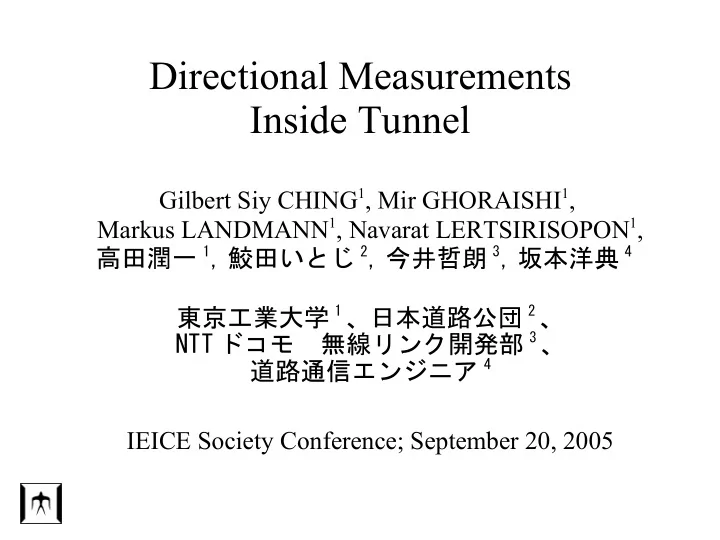

Directional Measurements Inside Tunnel Gilbert Siy CHING 1 , Mir GHORAISHI 1 , Markus LANDMANN 1 , Navarat LERTSIRISOPON 1 , 高田潤一 1 , 鮫田いとじ 2 , 今井哲朗 3 , 坂本洋典 4 東京工業大学 1 、日本道路公団 2 、 NTT ドコモ 無線リンク開発部 3 、 道路通信エンジニア 4 IEICE Society Conference; September 20, 2005
Outline - Introduction and Scenario - Channel Sounding - Measurement Positions - Parameter Estimation Algorithm - Results and Discussions - Conclusion Directional Measurements Inside Tunnel 2
Introduction Kinds of communication in tunnels - for frequencies up to hundreds of MHz, leaky feeders or radiating cables are used - in the GHz range, natural propagation results in low loss Communication inside tunnel is part of a wide range of roadside-to-vehicle and vehicle-to-vehicle communication for traffic management and public safety. Objective : To determine the dominant scatterers to know tunnel propagation behavior Directional Measurements Inside Tunnel 3
Scenario Shimizu 3 rd tunnel, 2 nd Tomei highway (3 lanes, arched ) 8.5 meters 16.6 meters Directional Measurements Inside Tunnel 4
Channel Sounding Wideband directional measurements using RUSK-DoCoMo channel sounder Frequency 5.2 Ghz Bandwidth 100 Mhz Delay resolution 10 ns TX Signal Multitone TX Antenna Vertically Polarized Dipole TX Power 40 dBm TX Height 7.95 meters (placed just below ceiling) Directional Measurements Inside Tunnel 5
Channel Sounding RX Antenna 24 dual polarized patch x 4 rings (to measure 360 degrees) Rayleigh Resolution 15 degrees (horizontal); 25 degrees (vertical) RX Height 2.53 meters (placed on top of car) Directional Measurements Inside Tunnel 6
Measurement Positions Co-Elevation Co-Elevation TX TX RX RX TX TX RX1 RX1 3.75m 3.75m + azimuth + azimuth RX2 RX2 3.75m 3.75m 40m 40m TX TX 35m 35m 40m 40m 3.75m 3.75m RX3 RX3 Jetfan Jetfan Directional Measurements Inside Tunnel 7
Parameter Estimation Algorithm RIMAX - a maximum likelihood based parameter estimator for multidimensional channel sounding Signal model is composed of - specular scattering - dense multipath components (distributed diffuse components) Used to estimate - Angle of arrival (azimuth and co-elevation) - Time of arrival - Complex path weights (vv and vh) Directional Measurements Inside Tunnel 8
Azimuth Delay Spectrum of RX1 Delay spread Az Co-ele [ns] spread spread [deg] [deg] 74 27 16 - figure plots the normalized azimuth delay spectrum averaged over co-elevation angle - scatterers with short and long delay exists - spread parameters of the estimated paths are computed Directional Measurements Inside Tunnel 9
Azimuth Delay Spectrum of RX1 Path Gain Delay[ns] Az Co- relative to LOS [deg] Ele [dB] [deg] 0 (LOS) 135 -3 83 -5 138 -2 82 -6.5 143 15 103 -7 138 -3 105 -9.5 138 10 76 - table shows the parameter of dominant scatterers - the dominant scatterers are plotted on the tunnel - paths does not necessary obey Snell's law. - measurement system can detect single bounce scatterers Directional Measurements Inside Tunnel 10
Azimuth Delay Spectrum of RX2 Path Gain Delay[ns] Az Co- relative to LOS [deg] Ele [dB] [deg] 0 (LOS) 135 3 83 Delay spread Az Co-ele -9 140 17 81 [ns] spread spread -12 143 -18 84 [deg] [deg] 54 28 11 -12 137 4 110 Directional Measurements Inside Tunnel 11
Azimuth Delay Spectrum of RX3 Path Gain Delay[ns] Az Co- relative to LOS [deg] Ele [dB] [deg] 0 (LOS) 135 6 83 -5 136 5 82 Delay spread Az Co-ele [ns] spread spread -6 150 22 107 [deg] [deg] -7 150 23 105 35 22 19 -13 138 -11 76 Directional Measurements Inside Tunnel 12
Scatterers Directional Measurements Inside Tunnel 13
Conclusion - initial report of wideband directional measurements inside tunnel - reflections from environment vary with position of receiver - reflections can cause undesired multipath that can degrade performance of communication systems - can reduce effect by properly designing radiation pattern of tx antenna, or putting absorbers on the scatterers Directional Measurements Inside Tunnel 14
Recommend
More recommend